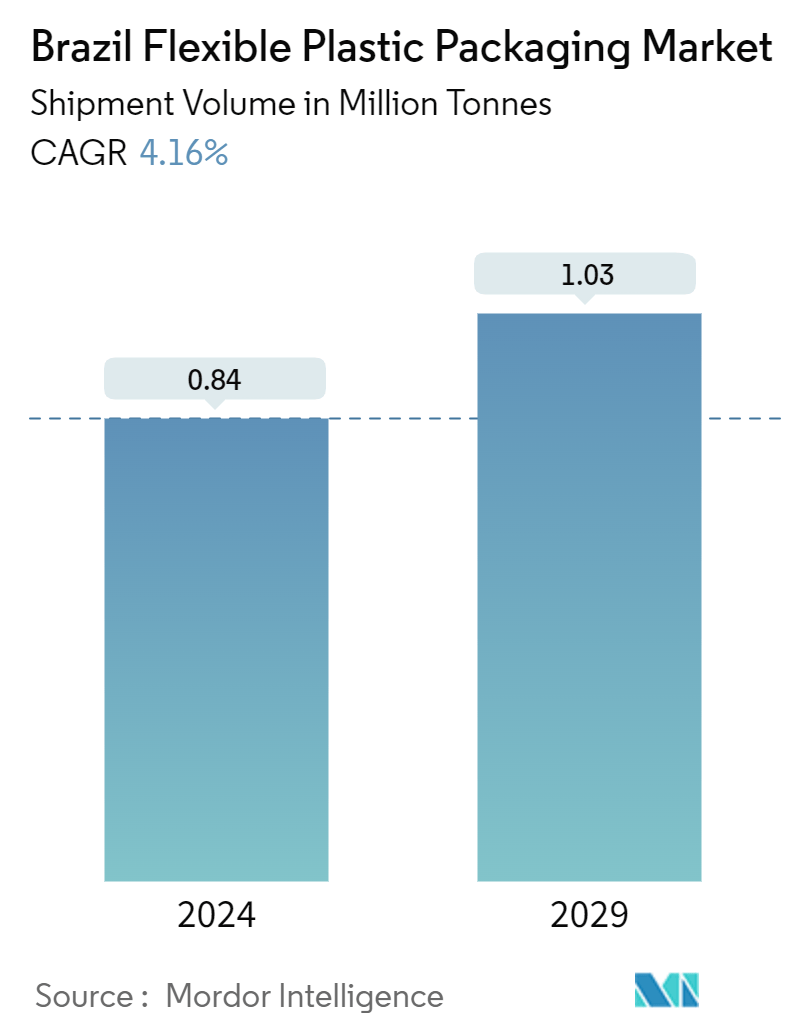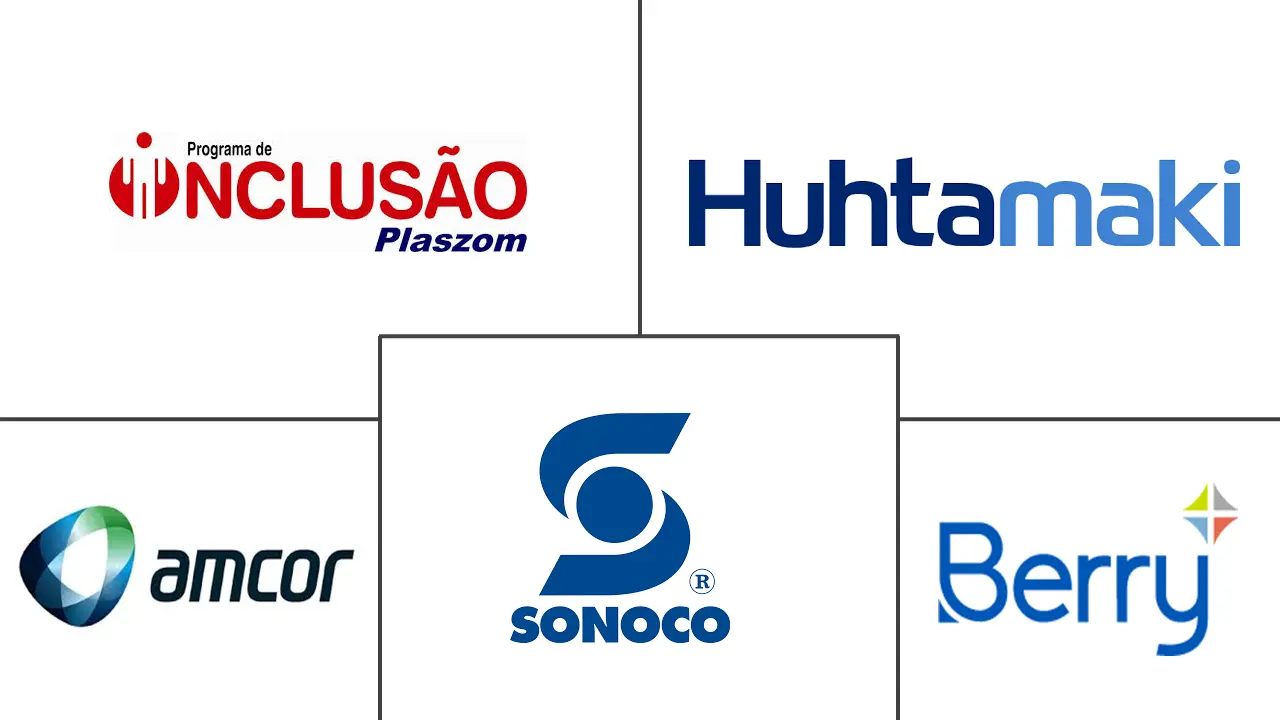Market Size of Brazil Flexible Plastic Packaging Industry

| Study Period | 2019 - 2029 |
| Base Year For Estimation | 2023 |
| Forecast Data Period | 2024 - 2029 |
| Historical Data Period | 2019 - 2022 |
| CAGR (2024 - 2029) | 4.16 % |
| Market Concentration | Low |
Major Players
*Disclaimer: Major Players sorted in no particular order |
Brazil Flexible Plastic Packaging Market Analysis
The Brazil Flexible Plastic Packaging Market size in terms of shipment volume is expected to grow from 0.84 Million tonnes in 2024 to 1.03 Million tonnes by 2029, at a CAGR of 4.16% during the forecast period (2024-2029).
Flexible packaging offers cost-effective and customizable solutions for product packaging. In Brazil, its popularity is surging, primarily due to its superior product protection. By keeping products intact, it effectively minimizes spoilage, thereby extending their shelf life.
- The increasing adoption of polyethylene (PE) and bi-oriented polypropylene (BOPP) materials for crafting flexible packaging, including bags, pouches, films, and wraps, is attributed to their versatility, durability, and cost efficiency. A key advantage of flexible packaging is its exceptional barrier properties against moisture, air, and contaminants. This feature ensures products maintain their freshness and integrity during transit and handling, propelling the market in Brazil.
- As snack trends in ready-to-eat and instant meals gain traction, there's a heightened demand for flexible plastic packaging in Brazil. This demand is further fueled by the country's appetite for processed and packaged foods and the desire to enhance their shelf life.
- Plastic, being highly versatile, finds extensive use in packaging across industries like pharmaceuticals, food, beverages, and cosmetics. Notably, Brazil stands out as the largest healthcare market in Latin America, as highlighted by the International Trade Administration. The burgeoning healthcare sector in Brazil is amplifying the need for flexible packaging solutions, ranging from pouches to laminated films.
- However, Brazil grapples with environmental concerns, particularly concerning plastic waste and recycling. Given that packaging stands as a significant contributor to plastic waste, the nation faces a pressing challenge in managing plastic pollution and disposal. Despite strides in exploring alternative materials and advancements in biodegradable plastics, the market's growth is hindered by this ongoing environmental issue.
Brazil Flexible Plastic Packaging Industry Segmentation
The study on the Brazilian flexible plastic packaging market tracks demands in terms of revenue for flexible plastic packaging by material, and it tracks the market size for respective end-user types. The estimates for the Brazilian flexible plastic packaging market include all the costs associated with flexible plastic packaging manufacturing, starting from the raw material procurement till it reaches the end-use industries. The estimates exclude the cost of the content that is or is to be packed inside the flexible plastic packaging. The scope of the flexible plastic packaging market is limited to B2B demand. Market numbers have been arrived at using both bottom-up and top-down approaches for segmentation, and volume has also been taken into consideration.
The Brazil Flexible Plastic Packaging Market Report is Segmented by Material (Polyethene [PE], Bi-Oriented Polypropylene [BOPP], Cast Polypropylene [CPP], Polyvinyl Chloride [PVC], Ethylene Vinyl Alcohol [EVOH], and Other Material Types [Polycarbonate, PHA, PLA, Acrylic, and ABS]), Product Type (Pouches, Bags, Films and Wraps, and Other Product Types), End-User Industry (Food [Frozen Food, Dry Food, Meat, Poultry, and Sea Food, Candy & Confectionery, Pet Food, Dairy Products, Fresh Produce and Other Food (Seasonings & Spices, Spreadables, Sauces, Condiments, etc.)], Beverage, Medical and Pharmaceutical, Personal Care and Household Care, and Other End User Industry [Automotive, Chemical, Agriculture]). The market sizes and forecasts regarding volume in (tonnes) for all the above segments are provided.
| By Material Type | |
| Polyethene (PE) | |
| Bi-oriented Polypropylene (BOPP) | |
| Cast Polypropylene (CPP) | |
| Polyvinyl Chloride (PVC) | |
| Ethylene Vinyl Alcohol (EVOH) | |
| Other Material Types (Polycarbonate, PHA, PLA, Acrylic, and ABS) |
| By Product Type | |
| Pouches | |
| Bags | |
| Films and Wraps | |
| Other Product Types (Blister Packs, Liners, etc) |
| By End-User Industry | ||||||||||
| ||||||||||
| Beverage | ||||||||||
| Medical and Pharmaceutical | ||||||||||
| Personal Care and Household Care | ||||||||||
| Other End user Industries ( Automotive, Chemical, Agriculture) |
Brazil Flexible Plastic Packaging Market Size Summary
The Brazilian flexible plastic packaging market is experiencing significant growth, driven by the increasing demand for cost-effective and customizable packaging solutions. This growth is largely attributed to the superior product protection offered by flexible packaging, which helps minimize spoilage and extend shelf life. The adoption of materials like polyethylene (PE) and bi-oriented polypropylene (BOPP) is on the rise due to their versatility, durability, and cost efficiency. These materials are particularly favored for their exceptional barrier properties, which protect products from moisture, air, and contaminants, ensuring freshness and integrity during transit. The burgeoning demand for flexible packaging is further fueled by the country's growing appetite for processed and packaged foods, as well as the rising trends in ready-to-eat and instant meals.
The market landscape is characterized by a diverse range of players, from global giants like Amcor PLC and Berry Global Inc. to local companies such as Videplast and Plaszom Zomer Industria De Plasticos Ltda. These companies are actively pursuing strategies like new product launches and mergers to expand their market presence. The healthcare sector, being the largest in Latin America, also contributes to the demand for flexible packaging solutions. However, environmental concerns regarding plastic waste and recycling pose challenges to market growth. Despite these challenges, the market continues to expand, supported by innovations in packaging design and the increasing use of recyclable materials. The evolving consumer preferences and lifestyle changes in Brazil are prompting packaging manufacturers to tailor their offerings, further driving the demand for flexible plastic packaging.
Brazil Flexible Plastic Packaging Market Size - Table of Contents
-
1. MARKET INSIGHTS
-
1.1 Market Overview
-
1.2 Industry Value Chain Analysis
-
1.3 Industry Attractiveness - Porter's Five Forces Analysis
-
1.3.1 Bargaining Power of Suppliers
-
1.3.2 Bargaining Power of Buyers
-
1.3.3 Threat of New Entrants
-
1.3.4 Threat of Substitutes Products
-
1.3.5 Intensity of Competitive Rivalry
-
-
-
2. MARKET SEGMENTATION
-
2.1 By Material Type
-
2.1.1 Polyethene (PE)
-
2.1.2 Bi-oriented Polypropylene (BOPP)
-
2.1.3 Cast Polypropylene (CPP)
-
2.1.4 Polyvinyl Chloride (PVC)
-
2.1.5 Ethylene Vinyl Alcohol (EVOH)
-
2.1.6 Other Material Types (Polycarbonate, PHA, PLA, Acrylic, and ABS)
-
-
2.2 By Product Type
-
2.2.1 Pouches
-
2.2.2 Bags
-
2.2.3 Films and Wraps
-
2.2.4 Other Product Types (Blister Packs, Liners, etc)
-
-
2.3 By End-User Industry
-
2.3.1 Food
-
2.3.1.1 Candy & Confectionery
-
2.3.1.2 Frozen Foods
-
2.3.1.3 Fresh Produce
-
2.3.1.4 Dairy Products
-
2.3.1.5 Dry Foods
-
2.3.1.6 Meat, Poultry, And Seafood
-
2.3.1.7 Pet Food
-
2.3.1.8 Other Food Products (Seasonings & Spices, Spreadables, Sauces, Condiments, etc.)
-
-
2.3.2 Beverage
-
2.3.3 Medical and Pharmaceutical
-
2.3.4 Personal Care and Household Care
-
2.3.5 Other End user Industries ( Automotive, Chemical, Agriculture)
-
-
Brazil Flexible Plastic Packaging Market Size FAQs
How big is the Brazil Flexible Plastic Packaging Market?
The Brazil Flexible Plastic Packaging Market size is expected to reach 0.84 million tonnes in 2024 and grow at a CAGR of 4.16% to reach 1.03 million tonnes by 2029.
What is the current Brazil Flexible Plastic Packaging Market size?
In 2024, the Brazil Flexible Plastic Packaging Market size is expected to reach 0.84 million tonnes.

